How many mutagens are missed under REACH due to limited low tonnage information requirements?
IF 3.5
4区 医学
Q1 MEDICINE, LEGAL
引用次数: 0
Abstract
For industrial substances registered under REACH at 1–10 tonnes per registrant/year, only the Ames test is required to address mutagenicity. When a substance tests positive in the Ames test, further testing is needed, but when the test result is negative, additional mutagenicity testing is only mandatory at a higher tonnage level. It is correspondingly known that some mutagens produced up to 10 tonnes per year/registrant are not identified. Based on battery (Q)SAR modelling, relying on agreement from both in vitro and in vivo models, advisory self-classifications (ASC) for mutagenicity are offered by the Danish EPA. In this present study, substances with ASC for mutagenicity are compared to the identified mutagens in low tonnage REACH registrations. We conclude that for only about a quarter of the low-tonnage substances with an Muta. 2 ASC, a positive experimental Ames result is available, leading to follow-up under REACH. We recommend improving the identification of mutagenic substances at the 1–10 tonnage band by including the in vitro micronucleus test to supplement the Ames test. Concerningly, the few low tonnage REACH dossiers that do provide in vivo data, mostly report negative micronucleus test results that are not conclusive due to missing information on bone marrow exposure.
由于有限的低吨位信息要求,在REACH下遗漏了多少诱变剂?
对于在REACH下注册的工业物质,每个注册人/年1-10吨,只需Ames测试即可解决致突变性问题。当一种物质在Ames测试中呈阳性时,需要进一步测试,但当测试结果为阴性时,仅在更高吨位水平上强制进行额外的诱变性测试。相应地,我们知道有些诱变剂的年产量为10吨/注册人,但没有加以确定。基于电池(Q)SAR模型,依赖于体外和体内模型的一致性,丹麦环保局提供了致突变性的咨询自我分类(ASC)。在本研究中,将具有ASC致突变性的物质与低吨位REACH注册中已确定的致突变性物质进行比较。我们得出的结论是,只有大约四分之一的低吨位物质具有Muta. 2 ASC,可获得积极的实验Ames结果,从而导致REACH下的后续工作。我们建议通过增加体外微核试验来补充Ames试验,以改进1-10吨位波段致突变物质的鉴定。值得关注的是,少数低吨位的REACH档案确实提供了体内数据,但大多报告了阴性的微核试验结果,由于缺少关于骨髓暴露的信息,这些结果不是结论性的。
本文章由计算机程序翻译,如有差异,请以英文原文为准。
求助全文
约1分钟内获得全文
求助全文
来源期刊
CiteScore
6.70
自引率
8.80%
发文量
147
审稿时长
58 days
期刊介绍:
Regulatory Toxicology and Pharmacology publishes peer reviewed articles that involve the generation, evaluation, and interpretation of experimental animal and human data that are of direct importance and relevance for regulatory authorities with respect to toxicological and pharmacological regulations in society. All peer-reviewed articles that are published should be devoted to improve the protection of human health and environment. Reviews and discussions are welcomed that address legal and/or regulatory decisions with respect to risk assessment and management of toxicological and pharmacological compounds on a scientific basis. It addresses an international readership of scientists, risk assessors and managers, and other professionals active in the field of human and environmental health.
Types of peer-reviewed articles published:
-Original research articles of relevance for regulatory aspects covering aspects including, but not limited to:
1.Factors influencing human sensitivity
2.Exposure science related to risk assessment
3.Alternative toxicological test methods
4.Frameworks for evaluation and integration of data in regulatory evaluations
5.Harmonization across regulatory agencies
6.Read-across methods and evaluations
-Contemporary Reviews on policy related Research issues
-Letters to the Editor
-Guest Editorials (by Invitation)

 求助内容:
求助内容: 应助结果提醒方式:
应助结果提醒方式:


